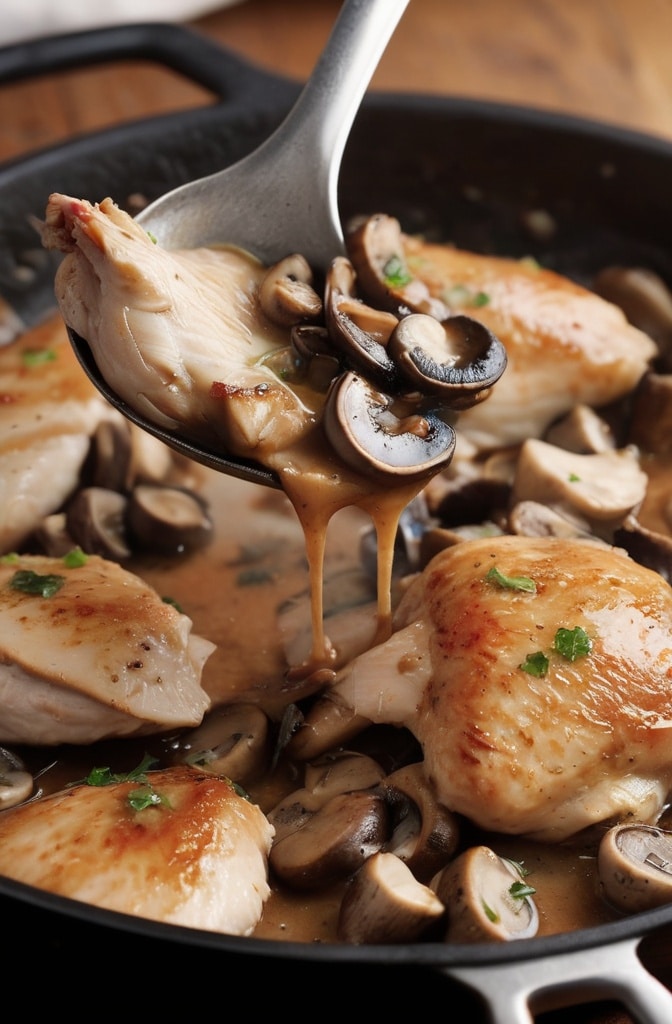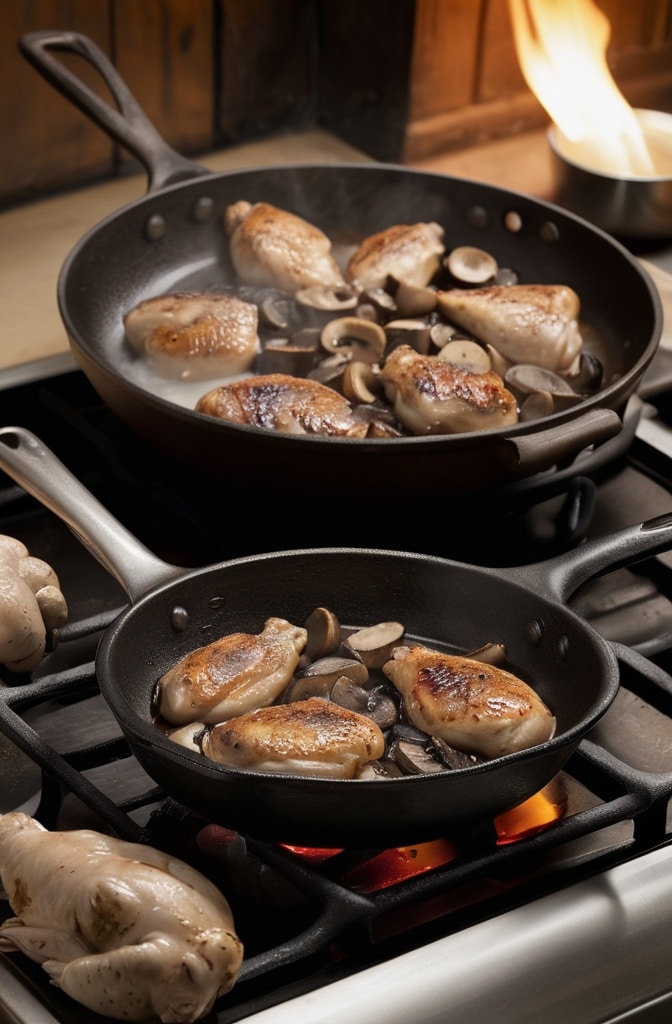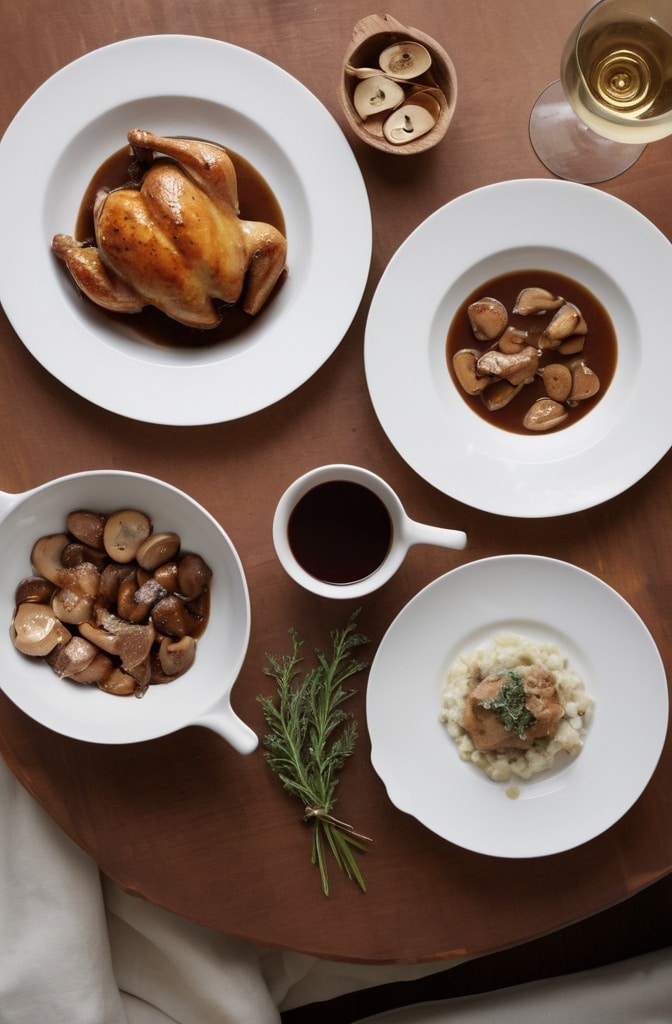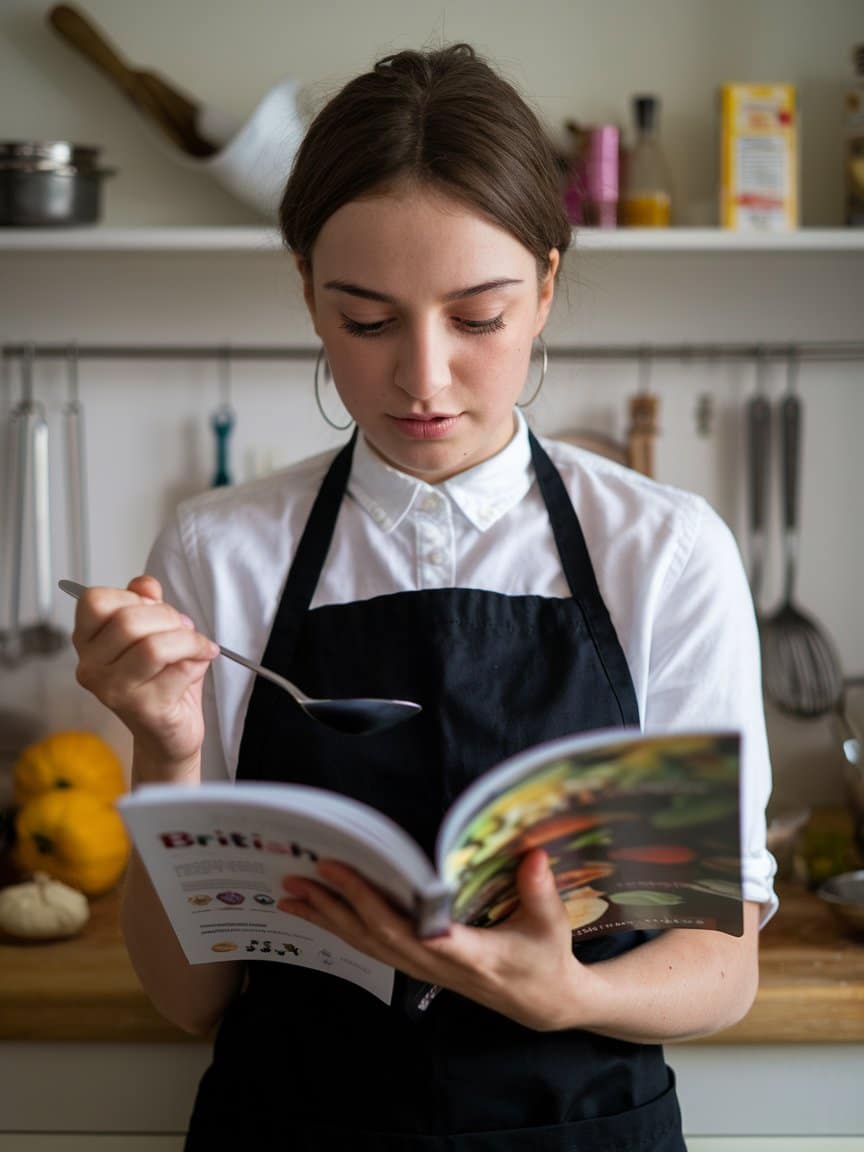A Culinary Symphony in One Pan
Have you ever caught yourself staring into your fridge at 5pm, wondering how to transform ordinary chicken breasts into something extraordinary? I certainly have. That’s how I stumbled upon perfecting what I now consider the ultimate weeknight luxury: Skillet Chicken and Mushroom Wine Sauce. It’s a dish that whispers of French bistro elegance while remaining firmly rooted in practical, achievable home cooking.

There’s something almost magical about the alchemy that happens when golden-seared chicken meets earthy mushrooms and a silky wine reduction. It’s one of those recipes that punches way above its weight class in terms of flavor-to-effort ratio. Trust me—I’ve made this for casual Tuesday dinners and served it to discerning dinner guests who demanded the recipe before dessert arrived.
This isn’t just another chicken recipe. It’s a masterclass in building flavors and utilizing a single pan to create a cohesive, restaurant-worthy dish that belies its simple ingredient list. The technique creates a beautiful marriage between the fond (those glorious browned bits on the pan), the earthiness of mushrooms, and the acidity of wine that, when combined, elevate humble chicken into the realm of culinary artistry.
Ingredients & Substitutions
For the Chicken:
- 4 boneless, skinless chicken breasts (about 6-8 oz each)
- Kosher salt and freshly ground black pepper
- 3 tablespoons all-purpose flour
- 2 tablespoons olive oil
- 2 tablespoons unsalted butter
For the Mushroom Wine Sauce:
- 1 pound mixed mushrooms (cremini, shiitake, oyster), sliced
- 1 large shallot, finely diced
- 3 cloves garlic, minced
- 1 tablespoon fresh thyme leaves (or 1 teaspoon dried)
- 1 cup dry white wine (Sauvignon Blanc or Pinot Grigio)
- 1 cup chicken stock (preferably homemade)
- 1/2 cup heavy cream
- 2 teaspoons Dijon mustard
- 2 tablespoons fresh parsley, chopped
When it comes to the chicken, you can absolutely substitute chicken thighs if you prefer darker meat. They’re acktually more forgiving and often more flavorful, though they’ll require a slightly longer cooking time. If you’re watching calories, boneless skinless thighs are still a fantastic option with less fat than their bone-in, skin-on counterparts.
For mushrooms, the mix matters. While cremini (baby portobellos) form a reliable base, adding wild mushrooms elevates this dish exponentially. Can’t find fancy mushrooms? No problem—even regular button mushrooms work, though I’d recommend roasting them a bit longer to concentrate their somewhat milder flavor. If your watching costs, stick with cremini and add a teaspoon of dried porcini powder for that umami depth.
The wine selection deserves special attention. A dry white wine with good acidity provides the backbone of this sauce. While Sauvignon Blanc is my go-to, any non-sweet white works beautifully. No wine in the house? Substitute with additional chicken stock plus a tablespoon of white wine vinegar or lemon juice to mimic that crucial acidity.
Step-by-Step Instructions
Preparing the Chicken
- Pat chicken breasts dry with paper towels—this is absolutely crucial for achieving that perfect golden sear. Season generously with kosher salt and freshly cracked black pepper on both sides.
- Place flour in a shallow dish and lightly dredge each chicken breast, shaking off excess. This thin coating will help the chicken brown beautifully while also slightly thickening our sauce later.
- Heat a large skillet (preferably cast iron or stainless steel—not nonstick) over medium-high heat. Add olive oil and 1 tablespoon butter. When the butter stops foaming, carefully place the chicken in the pan, being careful not to overcrowd. Work in batches if necessary.
Many home cooks make the critical mistake of moving the chicken too early. Let it cook undisturbed for 5-6 minutes until deeply golden on the first side. A properly seared protein should release naturally from the pan—if it’s sticking, it probly isn’t ready to flip yet.
Once golden, flip the chicken and cook for another 4-5 minutes on the second side. The internal temperature should reach 160°F (it will rise to the safe 165°F while resting). Transfer chicken to a plate and tent loosely with foil.
Creating the Mushroom Wine Sauce
- In the same skillet—and this is important, don’t clean that pan!—add the remaining tablespoon of butter. Add mushrooms in a single layer and let them cook undisturbed for 3-4 minutes. Those beautiful brown edges are concentrated flavor, so resist the urge to stir too frequently.
- When mushrooms have developed some color, add the diced shallot and cook for 2 minutes until translucent. Add garlic and thyme, cooking just until fragrant, about 30 seconds. Be vigilant here—garlic burns quickly and becomes bitter.
- Add the white wine and use a wooden spoon to scrape up all those magnificent browned bits from the bottom of the pan. This process, called deglazing, is where the magic happens. Let the wine reduce by half, which should take about 3-4 minutes at a steady simmer.
The aroma at this point is intoxicating—sharp wine mellowing into a fruity base note as it reduces, picking up the essence of the mushrooms and the fond left by the chicken. This is the foundation of our sauce and deserves patience.
- Pour in the chicken stock and bring to a simmer. Let reduce for about 5 minutes, then whisk in the heavy cream and Dijon mustard. The mustard isn’t just for flavor—it also acts as an emulsifier, helping to create that silky texture we’re after.
- Return the chicken to the skillet, nestling it among the mushrooms. Simmer gently for 2-3 minutes to reheat the chicken and allow it to soak up some of the sauce flavors.
For a slightly thicker sauce, you can sprinkle in a bit of flour or a cornstarch slurry (1 teaspoon cornstarch mixed with 1 tablespoon cold water). Personally, I prefer a sauce that’s just thick enough to coat the back of a spoon—what French chefs call “nappant.”
Cooking Techniques & Science
The brilliance of this dish lies in its layered approach to flavor development. We begin with the Maillard reaction—that complex chemical process when proteins and sugars in the chicken are transformed by heat into hundreds of new flavor compounds. This isn’t just browning; it’s creating depth that forms the foundation of our dish.

When we deglaze with wine, we’re using alcohol as a solvent to dissolve flavor compounds that are not water-soluble. Wine contains both alcohol and acid, which help lift and dissolve those browned proteins stuck to the pan (the fond). Scientifically speaking, we’re performing an extraction that captures flavors that would otherwise be lost.
The reduction process is equally important. As the wine and stock reduce, water evaporates while flavors concentrate. This reduction also causes proteins to unfold and interact, creating that silky mouthfeel we associate with restaurant-quality sauces.
Choice of pan matters tremendously for this recipe. A well-seasoned cast iron skillet provides unparalleled heat retention and distribution, while stainless steel gives us that perfect fond development. If you’re using nonstick, you’ll sacrifice some of those browned bits and subsequently, flavor.
Have you noticed how mushrooms seem to soak up all the fat in the pan before eventually releasing their own moisture? This happens because mushrooms contain a lot of water (about 90%), but their cell walls initially prevent that moisture from escaping. The heat breaks down these walls, eventually allowing them to release their liquid—and along with it, concentrated umami compounds.
Serving & Pairing Suggestions
This skillet chicken achieves its full potential when served immediately, while the sauce is still glistening and the chicken juicy. Transfer to warmed plates and spoon the mushroom sauce generously over and around the chicken. Finish with a light scattering of fresh parsley for color and that final herbaceous note.

For a complete meal, I recommend serving this with either a buttery mashed potato or creamy polenta—both excellent vehicles for capturing extra sauce. For a lighter option, roasted asparagus or haricots verts make perfect partners, their slight bitterness complementing the richness of the sauce.
Wine pairing deserves careful consideration. Since we’ve already opened a dry white for cooking, continuing with the same bottle makes perfect sense (assuming it’s of drinking quality). A crisp Sauvignon Blanc or unoaked Chardonnay complements without overwhelming. If you prefer red, opt for something with good acidity and moderate tannins like a Pinot Noir or Beaujolais.
For special occasions, consider elevating your presentation. Slice the chicken breast on a bias, fan it slightly, and pool the sauce around rather than over the meat. This restaurant technique showcases both the perfectly cooked chicken and the luxurious sauce.
When entertaining, this dish excels because it can be partially prepared ahead: sear the chicken and make the sauce earlier in the day, then simply reunite them and heat through just before serving. The flavors actually improve with a bit of time together.
The Art of Skillet Management
The real secret to this dish—beyond the ingredients or even the technique—is understanding the rhythm of heat management. Notice how we start with a hot skillet for searing but reduce the heat for sauce development. This control allows flavors to concentrate without burning or becoming bitter.

Many home cooks rush the sauce reduction, cranking the heat to speed things along. Patience yields dividends here; a slower reduction preserves the wine’s fruity notes while mellowing its alcoholic edge. When adding the cream, a gentle heat prevents curdling while allowing the sauce to thicken naturally.
Surface area plays a crucial role too. A wider skillet exposes more liquid to heat, speeding evaporation and reduction. If you find your sauce reducing too quickly, lowering the heat or partially covering the pan gives you better control.
The final consistency is a matter of personal preference, though ideally, this sauce should coat the back of a spoon while still flowing elegantly when poured. If it’s too thin, continue reducing; if too thick, a splash of stock thins it beautifully without diluting flavor.
Conclusion
Skillet Chicken and Mushroom Wine Sauce represents the pinnacle of practical sophistication in home cooking. It transforms everyday ingredients through thoughtful technique into something truly remarkable. The beauty lies in its adaptability—make it with whatever mushrooms look best at the market, whatever dry white wine you have open, whatever fresh herbs are thriving in your garden.
What elevates this from a simple weeknight dinner to a dish worthy of company is attention to detail: properly searing the chicken until golden, allowing mushrooms to develop caramelization before adding liquid, and having the patience to let a sauce reduce naturally rather than taking shortcuts.
Remember that cooking is as much about listening and observing as it is about following instructions. The sound of a proper sizzle when chicken hits the pan, the aroma shift when wine begins to reduce, the visual cues of a sauce that coats the back of a spoon—these sensory guideposts are often more valuable than strict timings.
Master this dish, and you’ve mastered not just a recipe but fundamental techniques that transfer to countless other culinary adventures. That’s the true gift of a great foundational recipe like this one—it teaches while it nourishes.
Frequently Asked Question?
Can I make this dish ahead of time?
Yes, though with some caveats. You can sear the chicken and prepare the sauce up to a day ahead, storing them separately in the refrigerator. When ready to serve, gently reheat the sauce, then add the chicken to warm through. Be careful not to overheat the chicken or it may become tough. Fresh herbs should always be added just before serving.
Why does my sauce sometimes break or curdle?
This typically happens when cream is added to a too-hot liquid or when the sauce boils after adding cream. The solution is simple: lower the heat before adding cream, and never let the sauce boil afterward. If it does break, sometimes a splash of cold cream and gentle whisking can rescue it.
Can I use bone-in chicken for more flavor?
Absolutely! Bone-in, skin-on chicken thighs or breasts add tremendous flavor but require adjustments. Increase initial searing time by 2-3 minutes per side, then finish the chicken in a 375°F oven for 15-20 minutes until internal temperature reaches 160°F before making the sauce. The fond development will be even better.
What’s the best way to reheat leftovers without drying out the chicken?
Gently reheat in a covered skillet over low heat with a tablespoon of additional stock or water to refresh the sauce. Alternatively, microwave at 50% power in short intervals, stopping to stir the sauce occasionally. The gentler heat prevents the proteins in the chicken from tightening and becoming tough.
Can I freeze this dish?
While possible, cream-based sauces generally don’t freeze well as they tend to separate when thawed. If you must freeze, do so before adding the cream, then add fresh cream when reheating. The chicken itself freezes reasonably well if properly wrapped to prevent freezer burn.

Veronica is a passionate food enthusiast with over three years of experience in exploring and writing about diverse cuisines. Her expertise lies in reviewing restaurants, sharing creative recipes, and discovering the latest food trends. As the voice behind FoodieRecap.com, Anju brings fresh perspectives and culinary insights to her audience.
